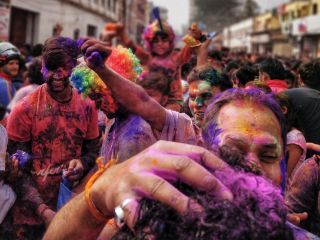Neuroscience
Want to Move On After a Painful Fight? Try a Ritual
Neuroscience and conflict experts recommend the power of rituals.
Posted February 2, 2023 Reviewed by Vanessa Lancaster
Key points
- Conflict analysis and management isn't the only approach. It tends to ignore the physical body, leaving many people "stuck."
- Many cultures use rituals to help conflicted parties get back in sync and embody improved relationships.
- One way that rituals work is through dissolving the sense of self and applying constructive pressure to be more prosocial.
- Moving in sync with someone increases a sense of social connection, trust, and safety and improves work done together.

After an intense disagreement with a spouse or friend, it can feel like you’re stuck in a loop going over the painful details. Maybe you snapped and are disturbed about how you acted. Or maybe just the general unpleasantness of the interaction has left you reeling, wondering what went wrong and how to prevent it from happening again.
Many of us, at this point, turn to conflict management books and seminars to help us analyze our conflicts and give us steps to take.
An intellectual and analytical approach like this can be helpful, but it’s important not to think of it as “the right way” to address conflicts.
One downside to dissecting your conflicts to try to figure them out is that while doing it, you might go “into your head.” You might be sitting still and doing a lot of evaluation of what happened. Usually, you’ll then develop some story about why you’re right and maybe think about what techniques to try to get the other person to do what you want them to do.
After all this work, you can still feel stuck, though.
Have you tried something simpler: Instead of sitting still and thinking, engaging your full body through rituals?
Being Analytical Isn’t Your Only Option
In his book Preparing for Peace: Conflict Transformation across Cultures, Professor of International Peacebuilding John Paul Lederarch explains that in many places, conflicts are successfully transformed without ever being abstractly analyzed.
People don’t focus as much on revisiting details and figuring out who did what to whom or who deserves what now. Instead, many of the world’s people focus on the whole person and relationships.
This can take a variety of forms. Often, conflicts are transformed by communities, not just the individuals involved. Shared rituals and ceremonies everyone knows how to perform are used to tap into transformative power, creating space for deep shifts of old conflict patterns.
Stories, proverbs, and teachings are given–in particular by trusted third parties like elders–to offer advice and wisdom to reorient the parties in the conflict who have temporarily lost their way.
Conflict patterns are felt, experienced, and redirected through dance, music, theater, and other arts. Communities eat together and perform other shared rituals like spiritual ceremonies that involve prayer, purification, and transformation.
A central focus of all of these activities is changing hearts–helping parties to recall their society’s prosocial values, to feel, and to embody improved relationships with each other.
Science Supports the Use of Rituals in Conflict Transformation
Anthropologists like Douglas Fry, Leslie Sponsel, and Brian Ferguson have done a great deal to raise awareness about the many community-based conflict transformation strategies employed around the world. These strategies regularly include successfully making use of rituals to address violence and heal relationships.
Nonetheless, in some secular materialist thinking, rituals are still looked down on as “backward” or “superstitious.” In recent years scientific evidence has caught up to the understanding that much of the world has had for a very long time: Rituals are powerful ways to transform how we feel and how we relate to each other and the world.
How do rituals work?
Shared rituals can help to dissolve your sense of self. We’re all familiar with disturbing stories of this–from cults to violent sports fans. But evidence also shows that when your individuality dissolves and you feel particularly connected to a group that puts positive and constructive pressures on you, you’re likely to behave more altruistically than you would on your own. Used in constructive ways, then, identity dissolving rituals coupled with constructive pressure from a group can be profoundly beneficial in overcoming conflicts.
Another interesting finding is that moving together with someone helps you feel more in sync with them. Harmonious movements seem to expand your sense of yourself to include the other person. Experiments show that not only can rituals with synchronized movements improve feelings of connection and social cohesion, but they can also even enhance your ability to work together on unrelated tasks. Shared movement can help you feel that the other party is more predictable and, thus, safer and more trustworthy. It can also make it easier for you to understand and empathize with them.
In the journal NeuroPeace Béatrice Pouligny and colleagues offer evidence from a range of studies showing that rituals can often:
- Support emotional regulation, anxiety reduction, and regulation of the nervous system (especially through the role that breathing plays in many rituals).
- Help people take their attention off of negative events—breaking cycles of unhealthy rumination.
- Improve performance under stress.
- Help people in making future plans.
- Convey peaceful intentions and more.
All of that can be immensely beneficial in generating new understandings and transforming conflicts.
In Conclusion, Try Taking a Walk
Even the simple act of taking a walk might help you think about a conflict in fresh ways. Research finds that walking boosts your creativity, giving you a change of scene. It also physically embodies the desire to move forward with your life rather than feeling stuck. Walking together while you talk to someone is also an easy way to get the benefits of synchronous movement mentioned above. Conflicts often take skill to navigate, but sometimes a simple ritual can go a long way.
References
To learn more about building understanding see my book: Are We Done Fighting? Building Understanding in a World of Hate and Division. https://arewedonefighting.com/




